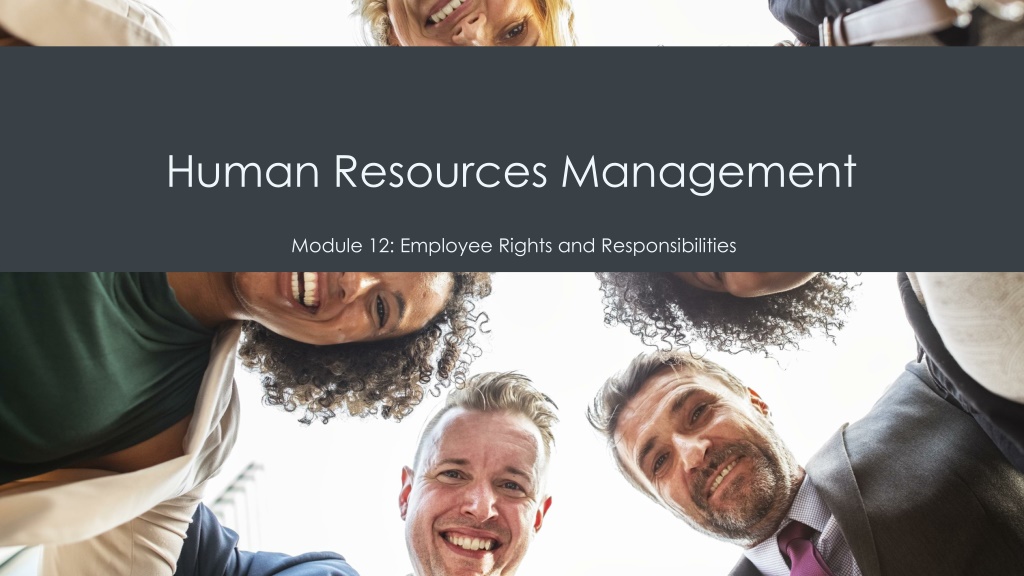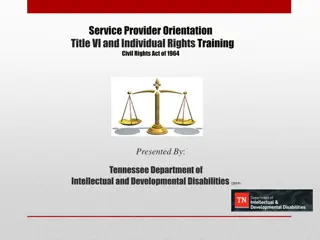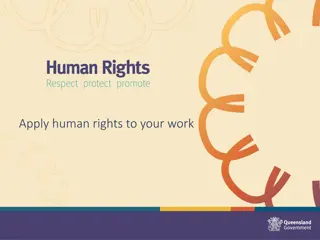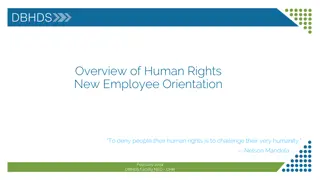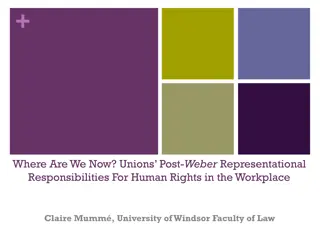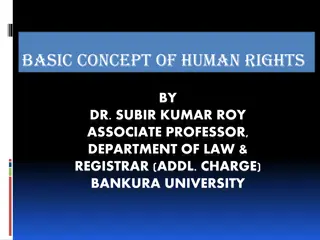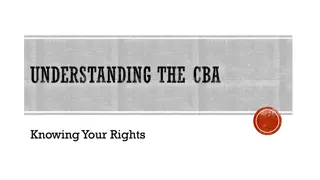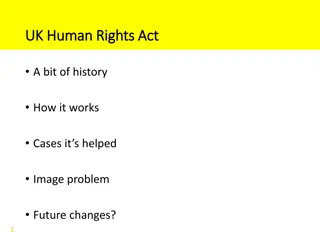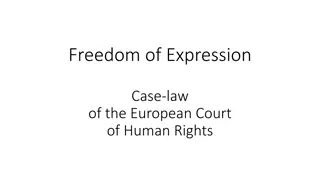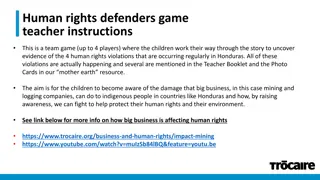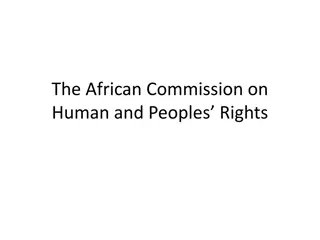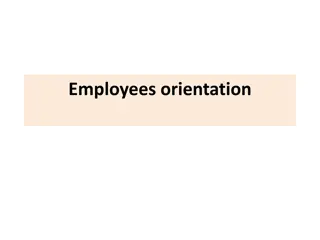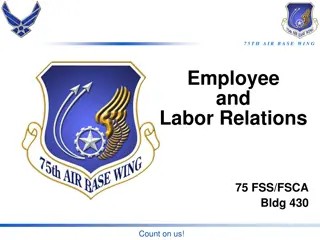Understanding Employee Rights and Responsibilities in Human Resources
This module delves into the laws and regulations governing employee rights and responsibilities in the workplace. Topics covered include laws related to employee information, behavior, and social media usage. Employee rights, such as those outlined in the Fair Credit Reporting Act and the Drug-Free Workplace Act, are discussed alongside employer responsibilities regarding employee privacy and layoffs. The module also touches on employee social media use as a form of concerted activity.
- Employee rights
- Human resources management
- Workplace laws
- Employer responsibilities
- Employee privacy
Download Presentation

Please find below an Image/Link to download the presentation.
The content on the website is provided AS IS for your information and personal use only. It may not be sold, licensed, or shared on other websites without obtaining consent from the author. Download presentation by click this link. If you encounter any issues during the download, it is possible that the publisher has removed the file from their server.
E N D
Presentation Transcript
Human Resources Management Module 12: Employee Rights and Responsibilities
Module Learning Outcomes Discuss the rights and responsibilities of employees and their employers 12.1: Discuss laws relating to employee rights 12.2: Discuss the employee-employer contractual relationship 12.3: Discuss disciplinary factors and guidelines
Learning Outcomes: Laws and Employee Rights 12.1: Discuss laws relating to employee rights 12.1.1: Discuss laws related to employee information 12.1.2: Discuss laws related to employee behavior outside the workplace 12.1.3: Discuss laws related to employee social media use
Employee Information Employee Information is governed by Federal, State, and local laws. These laws are designed to protect employees and their information. The Fair Credit Reporting Act: An employer must obtain written consent to run a candidate s credit, and notify them if their credit was the basis for any negative decisions The Drug-Free Workplace Act: Federal contractors and federal grantees must agree to provide a drug-free workplace if they receive a contract or grant of $100,000 or more
Employee Information (Continued) The Privacy Act: Requires federal government agency employers to provide employees with access to their personnel file The Worker Adjustment & Retraining Notification Act: Employers must inform employees of a layoff or closure affecting 50 or more workers Employee Polygraph Protection Act: Prohibits employers from using polygraphs during employment or employment screening
Employee Social Media Use Employee social media use can be covered as concerted activity for the following reasons: talking about wages and benefits, circulating a petition asking for better hours, participating in a refusal to work in unsafe conditions joining with co-workers to talk to your employer, a government agency, or the media about problems in the workplace Employees are not protected if they make statements that are egregiously offensive or knowingly and maliciously false, or disparaging your employers products or services without following a proper complaint process.
Employee Behavior Outside of Work An employer s behavior outside of work is regulated by state law. In general, state laws variously protect an employee s right to: engage in political activities volunteer for civic organizations smoke outside of working hours drink outside of working hours use lawful products outside of working hours
Practice Question 1 A company, who employs 500 workers, must lay off 15% of their workforce. They are notified by their HR department that they must give the employees who are affected by the layoff a 60 day notice. Which law requires the disclosure? A. The Fair Credit Reporting Act (FCRA) B. The Drug-Free Workplace Act C. The Privacy Act D. The Worker Adjustment & Retraining Notification Act (WARN)
Learning Outcomes: Employee-Employer Contracts 12.2: Discuss the employee-employer contractual relationship 12.2.1: Explain the Employment at Will Doctrine 12.2.2: Identify exceptions to the Employment at Will Doctrine
Employment at Will Doctrine The Employment at Will doctrine allows for either the employee or employer to terminate employment at any time, for any reason (except for an illegal one) This is an implied doctrine, although most employers will have you sign a document stating your employment is at-will The at-will doctrine can be modified by contract, such as stating employment can only be terminated for just cause
Exceptions to Employment at Will There are several exceptions to at-will employment Public Policy Exception: the public policy exception protects employees from adverse employment actions that violate a public interest. Some of the categories are: refusing to perform an act that state law prohibits engaging in acts that are in the public interest exercising a statutory right reporting a violation of the law Implied Contract Exception: an employer can create an implied contract if they use language that implies employment will continue for a certain amount of time or indefinitely (such as: your career is with us! ) Implied Covenant of Good Faith: just cause would be needed to fire an employee if it did not seem like the employer was acting in good faith
Practice Question 2 Which of the following is NOT an exception to the Employment at Will Doctrine? A. Public Policy Exception B. Implied Contract Exception C. Statutory Rights Exception D. Implied Covenant of Good Faith Exception
Class Activity: Employment at Will Discuss the following scenarios. Determine whether the employer is legally able to fire an employee, or if the employee would be protected under an exception to the at will doctrine. If the employee is protected, discuss the law or exemption that protects them. An employee is fired from work for wearing a grey shirt, because grey is the employer s least favorite color An employee signs a contract stating he will be fired for committing a crime while employed. He was fired for being late 4 days in a row. An employee was fired for refusing to lie on the stand at a trial. An employee was fired for lying about the number of hours they worked An employee was fired for filing a worker s compensation claim An employee was fired after their employer told them they would enjoy a lifetime of employment with the company
Learning Outcomes: Disciplinary Factors and Guidelines 12.3: Discuss disciplinary factors and guidelines 12.3.1: Discuss the purpose of discipline 12.3.2: Discuss the progressive discipline process
The Purpose of Discipline Effective organizations need to establish, communicate, and enforce standards of behavior and performance. The purpose of discipline is not to punish, but to instruct and correct by providing a consequence to undesirable behavior. Discipline comes into play when individuals disregard, fail to meet, or otherwise refuse to adhere to established codes of conduct or performance standards. It s essential to enforce desired behavior to avoid contaminating workplace culture Avoid having toxic behavior derail work groups, a department, or prompt a high- performing employee to leave
Progressive Discipline (cont.) 1. Verbal Warning. The first step is to issue an unofficial verbal warning. Even if the conversation is verbal, it should still be documented to include the date, purpose, and outcome of the warning for the employee s file 2. Written Warning. The supervisor should document the unsatisfactory behavior or performance, along with the informal warnings leading up to this point. 3. Suspension. If the behavior in the written warning from step 2 is not corrected by the outlined timeframe, an employee may be suspended from work for a timeframe ranging from a day to weeks, depending on the policy and scenario. 4. Termination. If the behavior that led to suspension is not corrected, termination may be warranted. The letter of termination should be delivered to the employee via certified mail or in person. Some offenses, such as sexual harassment, violence, or theft may be cause for immediate dismissal.
Class Activity: Progressive Discipline Consider the following scenarios. Discuss with your classmates which step of progressive discipline you would use, and why. An employee calls out sick after the work day has already started An employee continues to miss important information on contracts, even after you ve already spoken to them about it Three separate employees notify you about an employee who has made inappropriate sexual comments to them You discover an employee has not been accurately reporting cash sales An employee habitually becomes belligerent at company social functions
Quick Review Federal, state, and local laws are put in place to protect employees and employers in the workplace State laws determine how far an employer s reach can extend outside the workplace into employees personal lives Employee behavior that is considered concerted activity is protected under the National Labor Relations Act The US has an implied Employment at Will Doctrine, which allows either party to terminate an employment agreement for any legal reason There are several exceptions to the Employment at Will Doctrine that protects an employee from being terminated without just cause Discipline serves an important purpose in the workplace, and one best practice is progressive discipline
